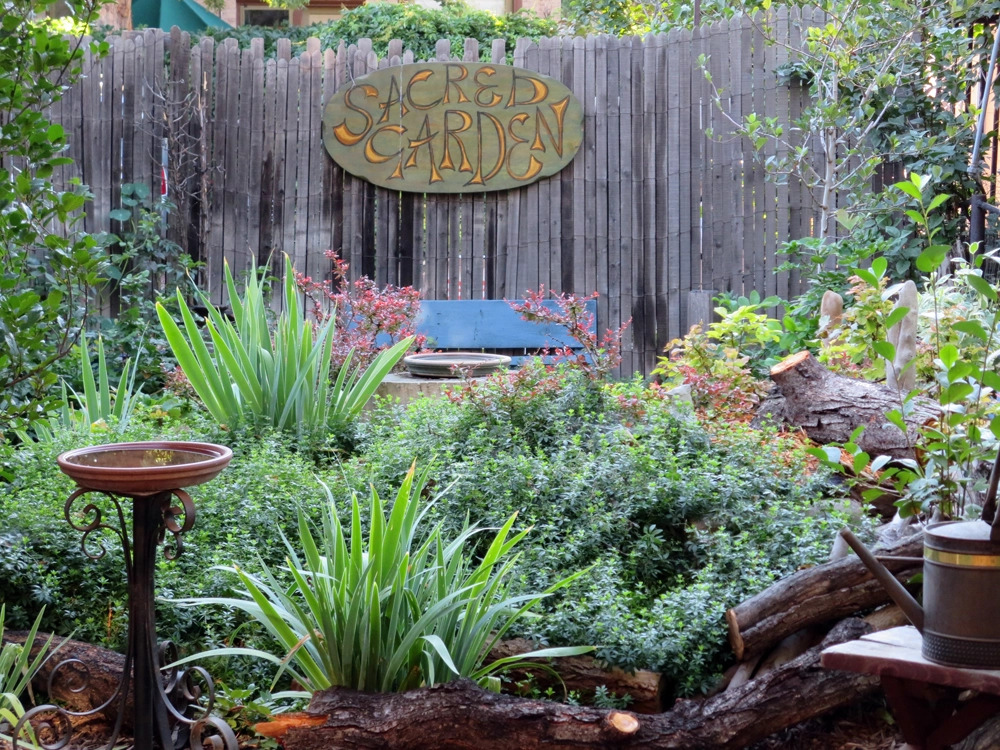Environmentally Friendly Urban Backyards
Because so much of America’s wild lands have been lost to urbanization, there is a crisis of habitat for the
wildlife that used to live in those areas. Where are they to go and what are they to eat and drink?
Even if our yards are small, we can each help to alleviate this problem by making them wildlife friendly. For
example, we can furnish a part of our yards with saucers of drinking water during the dry summer months. The
insects, birds and small mammals will use this as a precious life-saving resource.
Every day in summer I fill the four birdbaths in our front and back yards with fresh water, which the birds
visit in droves. I have seen eight birds at a time drinking and bathing in a single 18 inch planter!

So many backyards in our neighborhood are covered with grass and non-native plants that are unfriendly to
wildlife. Animals can only utilize certain plants as food and some are unusable or even poisonous. Grass is an
environmental disaster. It requires a prodigious amount of water, which in drought regions is irreplaceable.
Pesticides are generally used that poison the ecosystem and drain off into our rivers and oceans. People then
mow it and put the clippings in plastic bags which are hauled away (using fossil fuels) to the landfill. What a
tragedy!
The best alternative is mulching. Mulch is an easy way to create a healthy ecosystem and you don’t ever have to
mow. Tip: if you decide to mulch don’t begin by laying plastic sheets beneath your mulching material. Plastic
biodegrades at a glacial rate and will still be here in the year 2525. Plus, these sheets don’t allow anything
to grow or breathe underneath and kill off all the little insects that are essential to a thriving ecosystem.
Put flat sheets of cardboard beneath the mulch. These will quickly biodegrade, providing nourishment for the
plants and leading to a living ecosystem.
I can attest to this from my own experience. Janet and I live in Denver and we have created a garden that is
friendly to wildlife. The mulch in our yard provides a place where insects live, providing food for larger
animals. We have also planted natives such as mahonia and manzanita that provide forage for small wildlife.

We have learned so much from this process and we have the joy of watching animals visit our yard. We have chosen
to do this rather than have companion animals. We love cats and dogs, but it is the small wild creatures,
lacking their former habitat, who are most in need of protection.
After seeing the most basic of environmental protections under fire, it is easy to become cynical and ask
“what’s the use?” But if we each create a little bit of habitat for birds and other creatures, we will make it
possible for wildlife to live side by side with us in urban and suburban areas. Even if you have an apartment
balcony, you can leave a dish of fresh water outside and plant in a way that is ecologically harmonious. Connect
with local environmental groups or nurseries and find out what plants are most beneficial for all forms of
wildlife in your region.
Although we love dogs and cats, one essential of a wildlife garden is to provide safety from predators. Dogs and
cats must be kept away from this habitat or the wildlife will not come. We have planted a thicket composed of
twigs and branches, trimmed from trees and bushes, and we weave them into a fence that is now five feet high.
Small birds like to take shelter there. Almost all of the materials I have mentioned cost zero money and make
use of whatever is at hand in the backyard or the alleys. We get cuttings of native plants from our friends and
give cuttings to anyone who wants them. Tree services are often glad to deliver free mulch. It’s easy. It just
takes an open heart, a willing hand, and the rewards are beyond description.- Larry
Resources about ecofriendly urban gardens:
Garden Designs for Wildlife Gardens
Call of the Wild: Design Your Own Wildlife Garden